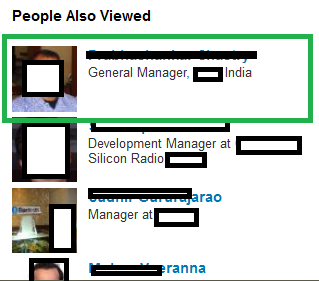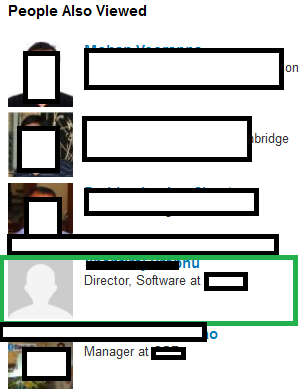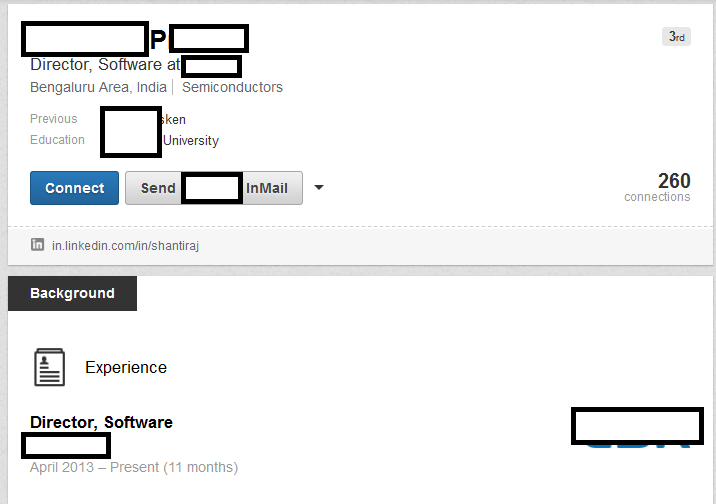 You will be able to view only 1-2 Million of profiles out of 18 Million profile on LinkedIn,
You will be able to view only 1-2 Million of profiles out of 18 Million profile on LinkedIn,
if you are a non premium customer
Since last 3 years, I spend more than half an hour on LinkedIn everyday. This is what corporate life does to us. LinkedIn is a one stop solution for almost anything you want to know in this corporate environment. I use LinkedIn for reading interesting article, knowing interesting people, marketing etc. Here is a restriction LinkedIn puts on any non-premium users :
[stextbox id=”grey”] You are not allowed to see full profile of some of the restricted 3rd level friends
(neither friends nor friend of friends) [/stextbox]
This article will give you a flavor of how you can use probability to think beyond what is visible to an average user in any social networking website. Here is simple tricks using probabilities on LinkedIn to overrule the restriction put by LinkedIn on its non premium users.
[stextbox id=”section”] Sizing of 3rd/3rd+ level locked Linkedin friend : [/stextbox]
Let’s start with estimating some numbers.
Total number of friends I have on my LinkedIn network = 1,700
Total number of 2nd degree friends on my LinkedIn network = 853,430
Total number of group users (share a group) = 973,323
The total of these numbers is the total number of profiles open to me to visit. I am likely to get profile restriction message for all other users. Let’s do a sizing of this number.
Say total number of users on LinkedIn = N
Number of friends of Mr.X = 10482
Number of common friends between Mr. X & Tavish Srivastava = 1
Say,
Probability of a person being a friend of Tavish = a = 1700/N
Probability of a person being a friend of Mr.X = b = 10482/N
Probability of a person being a friend of Mr.X & Tavish = c = 1/N
For independent events,
a * b = c
N = 1700 * 10482 / 1 = 17.8 Million
Number of profiles not open to me = 17.8 MM – 1.8 MM = 16 MM
[stextbox id=”grey”]
~16MM profiles on LinkedIn are not open to me because LinkedIn thinks I do not know the person enough
[/stextbox]
[stextbox id=”section”] 2 steps to unlock details of 3rd/3rd+ level Linkedin friend : [/stextbox]
LinkedIn restrict users to view a profile if it thinks you don’t know the person enough. This is the screen you get
We will like to open the full profile of this person without upgrading our account to premium. Let’s try to understand what factors linkedin takes into account before deciding whether a person X knows Y.
[stextbox id=”grey”]
Here are the behavioral attributes I can think of :
1. Number of common friends between X and Y
2. Number of common communities between X and Y
3. Profile matches between X and Y (University, company)
4. Any specific information X knows about Y ( like Email ID)
5. Last page viewed by X before landing to page of Y
[/stextbox]
4 out of the 5 attributes of this list are very difficult to trigger unless until X actually knows Y. Last criterion is something one can easily manipulated. Here’s a simple way to do the same.
X reaches a Y’s profile but Y’s profile is locked. LinkedIn has a tab on left hand side called “people also viewed”. Consider following event :
P(A) : Random person views Y’s profile
P(B) : Random person views B’s profile.
B’s name comes in Y’s “people also viewed” tab 1st name. Hence, P(B/A) is extremely high.
We all know that P(B/A) ~ P(A/B) or both move in the same direction. If P(B/A) is high P(A/B) will also be high.
[stextbox id="grey"] Step 1 : X clicks on B's icon in the Y's "people also viewed tab (As illustrated in the following figure) [/stextbox]
X finds Y on 4th number in the B’s “people also viewed” tab.
[stextbox id="grey"]
Step 2 : X clicks on Y's icon in the B's "people also viewed tab
(As illustrated in the following figure)
[/stextbox]
This time however X triggers 5th criterion for Y as well and hence linkedin shows X Y’s complete profile.
[stextbox id=”section”] End Notes : [/stextbox]
The algorithm works in most of the cases, however, in some cases you might not find the target in the list of “people also viewed” of the intermediate person. This is probably because you chose an intermediate person who might be much more popular than target person. In such cases try choosing people who have a closer relation to the target person. Please note that the article is based on my experience with analytics and frequent usage of LinkedIn, there is a possibility that we might have missed some of the variables LinkedIn takes into account. Do let us know of any attribute you think might be one of the variable LinkedIn takes into account and we missed to mention the same in this article.
Did you find the article useful? Share with us any other techniques which you know to make use of social networks in a better way. Also share with us any live examples of using probabilities in real world scenarios. Do let us know your thoughts about this article in the box below.









Tavish, You have stated that N is the total number of Linkedin users, but I guess that assumption is wrong because if it is so, N keep changing based on the number of friends that I have or Mr.X and its not true.. The total number of linkedin users will not change based on the friends that individual have, But N can be statednas the number of people within my network
Umesh, Thats a fair question.There are multiple factors influencing the number n. One of which as you rightly identified is no. of my friend. In case i increase my number of friend by say 100% , there is a probability number of common friends increase as well. Say number of common friend also increase to 2 . If you do the same calculation you will find the same number 18 MM. However, there is a small scope of inaccuracy in this case. If the number of common friends were more than 50, this calculation would have been more accurate. Hope this clarifies your query. Let us know your thoughts on the same. Tavish
Great hack, it works!